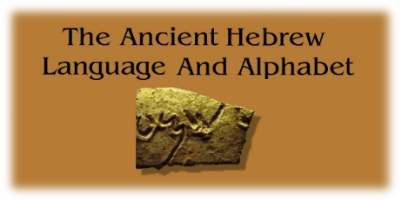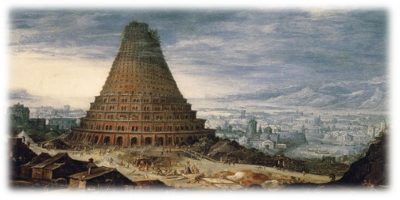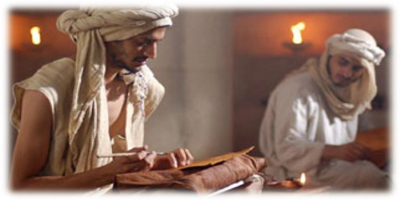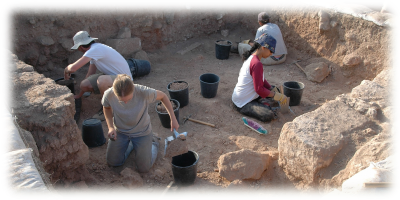
Archeological Discoveries
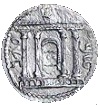
Oct 6th, 2014 - Amazing Find Near the Dead Sea:When Israeli archaeologists began excavating caves near the Dead Sea, they found a real treasure: nine rare silver coins that are believed to date back to a failed Jewish rebellion against the Romans in the second century A.D.
The Associated Press reports that archaeological finds relating to the three-year rebellion are rare, and these coins help tell the story of the families that Shimon Bar Kochba led into the caves of the Judean Desert at the end of the second Jewish uprising against the Romans to escape brutal repression--a move that resulted in their exile. Even historical records tell little about the rebellion that took place in 132 or its leader since neither side viewed it as a success and so wrote little about it.
Only 2,000 such coins are known to exist, so finding nine more is considered a great treasure. One of the nine coins is particularly rare. Called the Petra Drachma, it is a half-ounce of silver and is the largest Jewish coin ever issued. AP notes that one side of the coin shows Jerusalem's second Jewish temple, destroyed by the Romans during the first Jewish rebellion in the year 70. The other side shows another important Jewish symbol, the image of four plants, known as the four species, used during ceremonies for the festival of Sukkot.
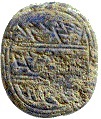
May 1, 2012 - 'Matanyahu' Seal Found near Solomon's Temple:Archeologists digging under Robinson's Arch in the archeological garden next to the Kotel have found remains of a structure from the late First Temple period, under the base of the drainage ditch currently being exposed.On the floor of the ancient structure, the diggers discovered an ancient Hebrew seal from the late First Temple period. It is made of semiprecious stone and bears the name of the owner of the seal: "To Matanyahu Son of Ho..." (the rest of the name is not legible).
"Finding a First Temple seal in the location closest to the Temple Mount is very rare and a very moving experience. It is like a tangible message from the person Matanyahu who lived here over 2,700 years ago. In the ancient structure under the base of the canal, we also found pottery shards typical of the period, on the floor, as well as fallen rocks and remains of a fire."
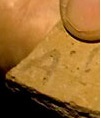
May 7th, 2012 - Oldest Hebrew Inscription Possibly Found:An Israeli archaeologist digging at a hilltop south of Jerusalem believes a ceramic shard found in the ruins of an ancient town bears the oldest Hebrew inscription ever discovered... The five lines of faded characters written 3,000 years ago, and the ruins of the fortified settlement where they were found, are indications that a powerful Israelite kingdom existed at the time of the Old Testament's King David.
Carbon-14 analysis of burnt olive pits found in the same layer of the site dated them to between 1,000 and 975 B.C., the same time as the Biblical golden age of David's rule in Jerusalem. Scholars have identified other, smaller Hebrew fragments from the 10th century B.C., but the script, which Garfinkel suggests might be part of a letter, predates the next significant Hebrew inscription by between 100 and 200 years.

Jan 7th, 2010 - Most Ancient Hebrew Biblical Inscription Deciphered:Prof. Gershon Galil of the University of Haifa who deciphered the inscription: "It indicates that the Kingdom of Israel already existed in the 10th century BCE and that at least some of the biblical texts were written hundreds of years before the dates presented in current research."
A breakthrough in the research of the Hebrew scriptures has shed new light on the period in which the Bible was written. Prof. Gershon Galil of the Department of Biblical Studies at the University of Haifa has deciphered an inscription dating from the 10th century BCE (the period of King David's reign), and has shown that this is a Hebrew inscription. The discovery makes this the earliest known Hebrew writing. The significance of this breakthrough relates to the fact that at least some of the biblical scriptures were composed hundreds of years before the dates presented today in research and that the Kingdom of Israel already existed at that time.
English translaton of the deciphered text:
- you shall not do [it], but worship the [Lord].
- Judge the sla[ve] and the wid[ow] / Judge the orph[an]
- [and] the stranger. [Pl]ead for the infant / plead for the po[or and]
- the widow. Rehabilitate [the poor] at the hands of the king.
- Protect the po[or and] the slave / [supp]ort the stranger.
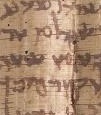
May 6th, 2009 - A Rare 2,000 Year Old Hebrew Document:The document is written in ancient Hebrew script, which is characteristic of the Second Temple period and the first and second centuries CE. This style of the writing is primarily known from the Dead Sea scrolls and various inscriptions that occur on ossuaries and coffins. The document itself is written on papyrus. The papyrus is incomplete and was in all likelihood rolled up. It is apparent that pieces of it crumbled mainly along its bottom part. The holes along the left part of the document probably attest to the damage that was caused to it over time. The document measures 15 x 15 centimeters. Fifteen lines of Hebrew text, written from right to left and one below the other, can be discerned in the document. In the upper line of the text one can clearly read the sentence "Year 4 to the destruction of Israel". This is likely to be the year 74 CE - in the event the author of the document is referring to the year when the Second Temple was destroyed during the Great Revolt. Another possibility is the year 139 CE - in the event the author is referring to the time when the rural settlement in Judah was devastated at the end of the Bar Kokhba Revolt. The name of a woman, "Miriam Barat Ya'aqov", is also legible in the document followed by a name that is likely to be that of the settlement where she resided: Misalev. This is probably the settlement Salabim. The name Miriam Bat Ya'aqov is a common name in the Second Temple period. Also mentioned in the document are the names of other people and families, the names of a number of ancient settlements from the Second Temple period and legal wording which deals with the property of a widow and her relinquishment of it.

Nov. 03, 1967 - The Temple Scroll:Since the first discovery of the Dead Sea Scrolls in 1947, the faded parchments of Qumran have provided extraordinary insights into the nature of Judaism at the time when Christianity was born. Now, Israeli Archaeologist Yigael Yadin has announced the discovery of a new scroll. Not only is it the longest so far discovered, but it may well prove to be the most important. Unlike the other parchments, which are either copies of Biblical texts or accounts of the history and practices of the Qumran community, the new scroll is a prophetic message, claiming to speak for God himself, that was clearly intended by its author to be incorporated into the Bible.
The new scroll is a series of commands to the people of Israel. Since nearly half of them deal with detailed instructions on the building and ritual maintenance of the temple, Yadin has tentatively named the document the "Temple Scroll." The minute specifications call for the construction of three courts in the form of concentric squares; the two outer courts must each have twelve gates, named for the twelve tribes of Israel. Curiously, it also requires that public toilets should be constructed 1,400 meters northwest of the temple-which, notes Yadin slyly, would situate the lavatories today somewhere near the old Mandelbaum Gate leading to what was Arab Jerusalem.
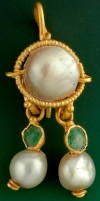
Nov. 10th, 2008 - 2,000-year-old gold earring found in Jerusalem:The piece was found beneath a parking lot next to the walls of Jerusalem's Old City. It dates to the Roman period just after the time of Jesus, said Doron Ben-Ami, who directed the dig. The earring was uncovered in a destroyed Byzantine structure built centuries after the piece was made, showing it was likely passed down through generations, he said.
Archaeologists came upon the earring in a corner while excavating the ruins of the building under a parking lot. "Suddenly one of the excavators came up shouting 'Eureka!'" said Ben-Ami. The find is eye-catching: A large pearl inlaid in gold with two drop pieces, each with an emerald and pearl set in gold. "It must have belonged to someone of the elite in Jerusalem," Ben-Ami said. "Such a precious item, it couldn't be one of just ordinary people."

Aug 20th, 2008 - Clay Bulla Documents Biblical Hebrew King:Israeli archaeologists this week unearthed a 2,600-year-old bulla, which is a clay seal impression, bearing the name Gedaliah ben Pashur, who was a minister at the court of King Zedekiah, the last Jewish ruler of Jerusalem just prior to the Babylonian destruction of the First Temple.
Ben Pashur is mentioned in the Book of Jeremiah (38:1) together with another courtly politician, Yehuchal ben Shelemayahu. His name was found on an identical clay bulla discovered in 2005 at the same archaeological excavations in the ancient City of David outside Jerusalem's Old City walls near the Dung Gate.

Jul 7th, 2008 - Dead Sea tablet suggests Jewish resurrection imagery pre-dates Jesus:The premise that the Messiah died and was resurrected after three days is considered the foundation of the Christian faith, one which differentiates it from Judaism. Through the generations, this belief stood at the center of the debate between Christians and Jews. But now, a mysterious tablet from the time of the second temple has led researchers to believe that this premise of messianic resurrection is not unique to Christianity, but rather existed in Judaism years before Jesus was born.
"This is a revolutionary text," Knohl said when presenting his research at a conference marking 60 years since the discovery of the Dead Sea Scrolls held this week at the Israel Museum in Jerusalem. "The text changes the way we look at the historical Jesus, and provides a missing link connecting Judaism and Christianity," he added.
In the "Gabriel's vision" text there are 87 lines. Toward the end, on the 80th line, there is an unclear sentence containing the words "shloshat yamin" (three days). The next word is broken up, and when the text was first published, three dots were used in its place. However, Professor Knohl recognized it as "Hayia", which he interpreted to be the command form of the work "Hai", to live, concluding that the text is describing the angel Gabriel as someone who raises from the dead the prophet leader named "Minister of ministers" three days after his death. He associates this minister with a historic figure-a Jewish leader named Shimon who declared himself king and led a failed rebellion against Herod in the year 4 B.C.E. until he was killed by Herod's army.
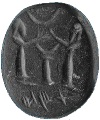
Jan 17th, 2008 - First Temple seal found in Jerusalem:A stone seal bearing the name of one of the families who acted as servants in the First Temple and then returned to Jerusalem after being exiled to Babylonia has been uncovered in an archeological excavation in Jerusalem's City of David, a prominent Israeli archeologist said Wednesday.
The 2,500-year-old black stone seal, which has the name "Temech" engraved on it, was found earlier this week amid stratified debris in the excavation under way just outside the Old City walls near the Dung Gate, said archeologist Dr. Eilat Mazar, who is leading the dig.
According to the Book of Nehemiah, the Temech family were servants of the First Temple and were sent into exile to Babylon following its destruction by the Babylonians in 586 BCE.

Jul 10, 2007 - British Museum Makes Important Breakthrough in Biblical Archeology:An expert working at the British Museum has confirmed the existence of an important Biblical figure after deciphering a cuneiform inscription on a small Babylonian clay tablet.
Austrian Assyriologist Dr Michael Jursa made the breakthrough discovery confirming the existence of a Babylonian official mentioned in the Old Testament and connected to the Babylonian king Nebuchadnezzar.
The clay document is dated to the 10th year of Nebuchadnezzar II (595 BC) and names the official, Nebo-Sarsekim. According to chapter 39 of the Book of Jeremiah, he was present at the siege of Jerusalem in 587 BC with Nebuchadnezzar himself.
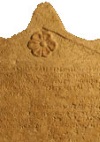
May 3, 2007 - Israel Museum Presentation Marks First Public Display of the "Heliodorus Stele":The Israel Museum unveiled today a unique 2,200-year-old stele (inscribed stone block) that provides new insight into the dramatic story of Heliodorus and the Temple in Jerusalem, as related in the Second Book of Maccabees.
"The Heliodorus stele is one of the most important and revealing Hellenistic inscriptions from Israel," said James S. Snyder, Anne and Jerome Fisher Director of the Israel Museum. "It contextualizes the Second Book of Maccabees and provides an independent and authentic source for an important episode in the history leading up to the Maccabean Revolt, whose victorious conclusion is celebrated each year during the Jewish festival of Hanukkah."
The newly deciphered stele presents new information about Heliodorus, who, according to the Second Book of Maccabees, received orders to seize the treasure in the Temple in Jerusalem, but was driven from the sanctuary by the miraculous appearance of a fearsome horseman accompanied by two mighty youths.
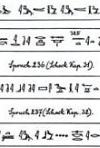
Jan 23, 2007 - Ancient spell may be oldest Semitic text Phrases designed to repel snakes from tombs of Egyptian kings:A magic spell to keep snakes away from the tombs of Egyptian kings, adopted from the Canaanites almost 5,000 years ago, could be the oldest Semitic text yet discovered, experts said Tuesday.
The phrases, interspersed throughout religious texts in Egyptian characters in the underground chambers of a pyramid south of Cairo, stumped Egyptian experts for about a century, until the Semitic connection was found.
In 2002 one of the Egyptologists e-mailed the undeciphered part of the inscription to Richard Steiner, a professor of Semitic languages at Yeshiva University in New York. Steiner discovered that the phrases are the transcription of a language used by Canaanites at some point in the period from 25th to the 30th centuries B.C.
"This is the oldest connected text that we have in any Semitic language," Steiner said in a telephone interview while visiting Israel to present his findings in a lecture sponsored by the Academy of the Hebrew Language. The previous oldest Semitic text dates from the 24th century B.C., Steiner said.

Nov. 03, 1967 - The Temple Scroll:Since the first discovery of the Dead Sea Scrolls in 1947, the faded parchments of Qumran have provided extraordinary insights into the nature of Judaism at the time when Christianity was born. Now, Israeli Archaeologist Yigael Yadin has announced the discovery of a new scroll. Not only is it the longest so far discovered, but it may well prove to be the most important. Unlike the other parchments, which are either copies of Biblical texts or accounts of the history and practices of the Qumran community, the new scroll is a prophetic message, claiming to speak for God himself, that was clearly intended by its author to be incorporated into the Bible.
The new scroll is a series of commands to the people of Israel. Since nearly half of them deal with detailed instructions on the building and ritual maintenance of the temple, Yadin has tentatively named the document the "Temple Scroll." The minute specifications call for the construction of three courts in the form of concentric squares; the two outer courts must each have twelve gates, named for the twelve tribes of Israel. Curiously, it also requires that public toilets should be constructed 1,400 meters northwest of the temple-which, notes Yadin slyly, would situate the lavatories today somewhere near the old Mandelbaum Gate leading to what was Arab Jerusalem.
 | Join my mail list and discover new insights into the language and culture of the Bible — plus, get a FREE e-book |



